Peanuts are the most widespread grain legume in the world, grown in over 100 countries to provide an adaptable and reliable oil and protein source. Because of the peanut’s global significance, ensuring a diverse and evolving varietal gene pool is a top priority for breeders, but the modern peanut hides an intrinsic fault.
A genetic bottleneck
The cultivated peanut’s fancy jumbo shells and high oleic seeds disguise a genetic weakness. All modern peanut cultivars owe their lineage to a single wild variety developed as a result of two diploid wild varieties spontaneously converging. That fact erects a genetic dead end amid a time of evolving pests and environmental change. North Carolina State University researchers are diving deep into the peanut gene pool to push variety improvement forward by reintroducing its wild roots.
“Genetic diversity is at the core of breeding programs. But we know that some spontaneous event occurred millennia ago causing a great bottleneck in the diversity of the wild tetraploid peanut species that we have since cultivated,” Jeff Dunne, an NC State assistant professor said. “It created an inherent lack of diversity in cultivated peanuts, which limits the breeding progress we can make in disease, drought, or pest resistance.”
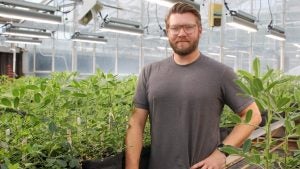
Shifting pathogens demand attention
In North Carolina, Bailey II has become the dominant variety since its release in 2017. Prized for its Early Leaf Spot resistance, Bailey II is helping U.S. farmers nearly eradicate the disease and its necessary spray treatments. But as one disease recedes, another rises.
Late Leaf Spot has now become a common, fast-moving economic threat. It causes plant defoliation that dramatically reduces yield and results in annual losses of $53 million according to the Peanut Research Foundation.
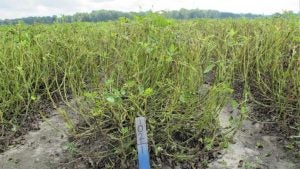
To breed resistant varieties, researchers are finding promise far back in the peanut’s family tree.
83 & me
Cultivated peanuts trace their lineage along an enormous family tree. They are a member of the pea family with 83 (and counting) wild species and two cultivated subspecies in the genus.
The genetically-limited lineage of modern peanut cultivars presents a breeding challenge.
For decades, plant breeders combed the globe discovering, collecting and cataloging wild species and local landraces. Worldwide, there are over 90,000 peanut lines in germplasm collections, albeit with much duplication.
NC State maintains one such peanut gene bank with 780 cultivated germplasm lines plus 217 wild species for breeding. The U.S. Department of Agriculture, the University of Georgia, and Texas A&M University boast the largest U.S. collections, but groups freely share resources.
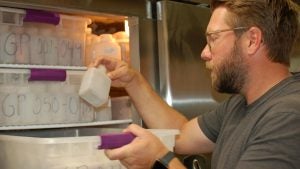
Navigating a 3.0 Gb map
The peanut family is divided into two camps of genetic structure that render them incompatible for breeding. Among wild species, some are diploid (carrying two copies of chromosomes) and some are tetraploid (four copies). While closely related, they cannot be directly crossed.
For European export value and other reasons, the U.S. peanut industry shuns genetic modification in production-peanut varieties. This limits researchers to traditional breeding techniques, which naturally render high variability. Layer on the incompatible genetic structures among wild species and breeding work becomes a bit like trying to repair a new Chevy with old Ford parts.
Breeders have solved part of the puzzle by developing creative tactics to merge the incompatible wild species. But once crossed, a DNA roadmap is crucial to identify chromosomes and sites of interest within the peanut genome’s 2.5 billion base pairs.
Peanut genome sequencing was completed in 2019 as an international effort among U.S. researchers, the National Peanut Board, and the Peanut Research Foundation. Phase one of the project created a 3.0 Gb reference genome and sequenced several varieties, which helps breeders make faster, more informed gene site selections.
Phase two now puts that knowledge into action. Breeders such as Dunne are using molecular marker technologies and genomic selection to target several pillars of improvement: disease, aflatoxin and drought resistance as well as flavor improvement.
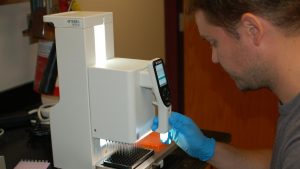
Promise from the wild side
Peanut research has a strong heritage at NC State. In the 1960’s W.C. Gregory, and later H. Tom Stalker, used wild species to develop and curate valuable germplasm that have been used around the world to improve peanut cultivars.
Seeds from collected wild species peanuts look dramatically different than cultivated varieties.
Evolved to locally adapt and resist pest pressures, the wild side of the family tree holds great promise to breeders like Dunne. The challenge lies in identifying the valuable genes and then reliably introducing them into cultivated stock.
Recently, University of Georgia researchers discovered that a Brazilian cross (IAC 322), which owes heritage to Gregory and Stalker’s work, carries an extra gene block on lucky chromosome 13 that provides Late Leaf Spot resistance. Dunne’s program has also identified a line (SPT 10-12) that has the additional gene and another that may further improve Late Leaf Spot resistance.
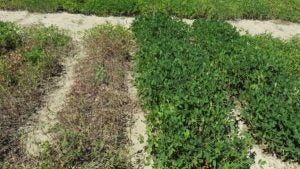
NC State’s highly successful Bailey and Bailey II varieties acquired their Early Leaf Spot resistance from genetic blocks on chromosomes two and eight. But both Baileys lack the block on 13, which is present in the newly identified lines.
These discoveries are spurring renewed vigor in many peanut breeding programs, recently at the University of Georgia and also at NC State.
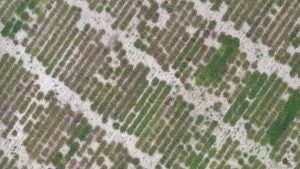
If you breed it, will they plant it?
“As breeders, we are in the business of creating yield,” Dunne said. “Integrating wild species into cultivated stock could significantly improve genetic diversity and add resistance traits. But it can create a yield drag.”
Despite the upside of new traits, the fear of yield decline deters some growers from planting new varieties. Dunne thinks that variety adoption comes down to building trust between growers and the breeding program.
“Varieties have hit all-time yield highs, which has actually reduced the amount of planted acreage because the yields are so good,” he said. “Our program’s goal is to maintain yield and improve margins with new varieties,” he said.
Resistance = Sustainable Management
Extension guidance highlights crop rotation and host resistance as the foundation of disease control. Combined with good agronomic practices, growers can minimize their losses and use of crop protection chemicals.
“Dr. David Jordan does an excellent job with peanut Extension programming — emphasizing crop rotations and optimizing fungicide programs,” Dunne said. “ But with upcoming chemical label changes and few new fungicide chemistries in the works, planting varieties for preventative, rather than curative, disease management may be increasingly appealing.”
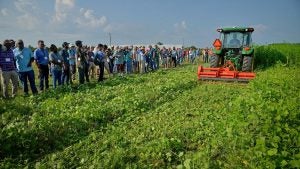
A packed peanut pipeline
Dunne’s breeding pipeline is well stocked. “My predecessor, Dr. Tom Isleib, left us with a tremendous amount of high-quality material,” he said. “His work set up our program to not only improve growers’ yields but to increase their margins. We’ve become a more sustainable breeding program.”
Dunne has selected two high-value Virginia-type varieties to release recently.
NC20 is later maturing than Bailey II, which allows growers to stagger harvest time and make the best use of limited harvest equipment and storage. The variety’s high disease resistance allows growers to leave it in the field longer despite high seasonal disease pressure.
Another introduction coming available soon is NC21, a large pod, large-seeded variety with equal disease resistance replacing the Wynne cultivar, which is coming off NC Foundation seed.
NC20 should be commercially available by 2024 and NC21 by 2025.
This article was submitted by North Carolina State University. Crop and Soil Sciences’ research impacts farmers, students, and N.C. citizens through innovations in food, feed, fuel and fiber. Follow how their discoveries affect agriculture and environmental science by joining the weekly newsfeed.


